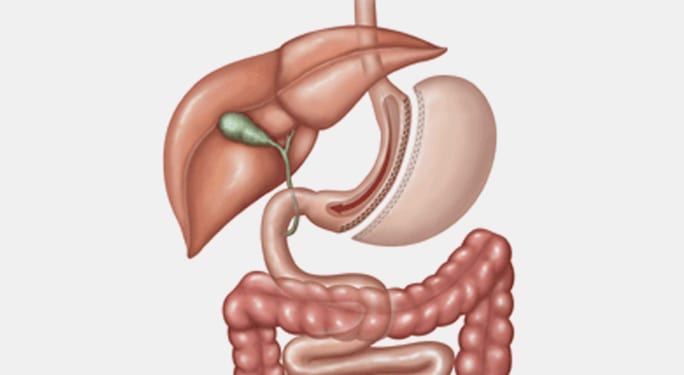The sleeve gastrectomy is a key hole surgery only on the stomach (it is only a restrictive procedure) and does not involve any surgery on the intestine (which would make it malabsorptive). Sleeve gastrectomy has also been called tube gastrectomy and vertical sleeve gastrectomy. It is basically consists of converting a stomach that looked like a pouch into a long tube; therefore the name “sleeve.”
The sleeve gastrectomy (SG) removes three-quarters of the stomach, which provides for quicker satiety (sense of fullness) and decreased appetite. The smaller stomach sleeve restricts food intake by allowing only a small amount of food to be eaten at one time. The value at the outlet of the stomach remains, this provides for the normal process of stomach emptying to continue which allows for the feeling of fullness.
SG has been utilized in the treatment of obesity since 2003. There are no new connections made between the stomach and small intestine in this procedure. There is no rerouting of the intestine. There is no malabsorption. There is no dumping syndrome. The Sleeve Gastrectomy is believed to have an advantage over the Adjustable Gastric Band due to removal of the part of the stomach that produces the hormone (Ghrelin) that controls the desire to eat.
The potential complications of the operation on an average are typically less than 1.5%.
WEIGHT LOSS (BARIATRIC) SURGERY REQUIRES LONG-TERM MONITORING AND CHANGES TO DIET AND LIFESTYLE.
Studies show that patients who commit to eating healthy food, take nutritional supplements and have routine blood work for monitoring purposes have the best long-term results.
Surgery gives patients a tool to assist with weight lost. Patients must be committed to making the emotional and physical changes necessary after weight loss surgery. This commitment will ensure successful weight loss and long-term weight maintenance.
Lack of exercise, poorly balanced meals, constant grazing, eating processed carbohydrates and drinking sweet beverages are some of the most common reasons for weight regain.
SLEEVE GASTRECTOMY ADVANTAGES
The sleeve gastrectomy has the following advantages:
-
It does not require the implantation of a foreign body such as a silastic ring, port and connecting tube used in gastric banding.
-
The procedure mechanically decreases the size of the stomach which decreases the secretion of the hormone (Ghrelin) that is responsible for appetite.
-
Patients should lose around 60-70% of their excess weight over 12 months.
-
Patients generally have a better eating quality of life
(eg. able to eat bread and meat easily). -
Good documented evidence of remission or improvement of medical conditions such as: diabetes, hypertension and sleep apnea.
SLEEVE GASTRECTOMY RISKS
The sleeve gastrectomy has the following advantages:
-
An internal infection from leakage of digestive juices from the gastric staple line-is uncommon. This usually requires surgery to repair.
-
Significant bleeding from the gastric staple line is a rare occurrence.

